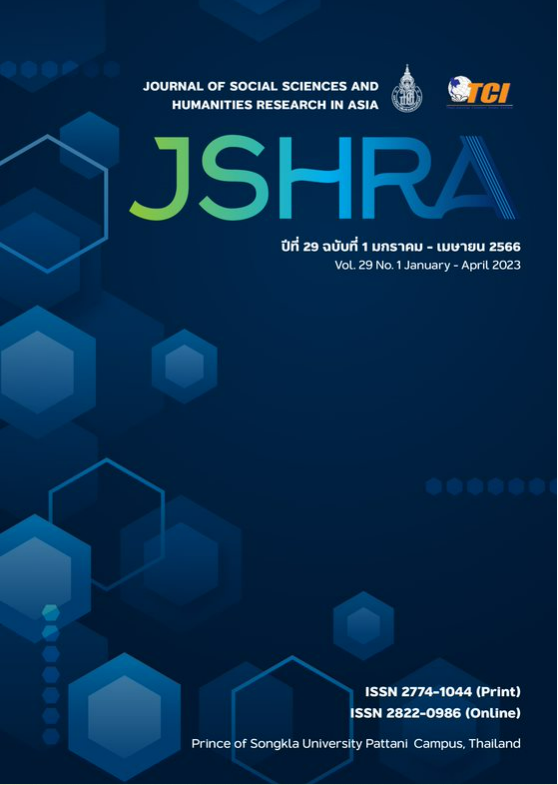ความรอบรู้ทางสุขภาพของผู้มีภาวะเสี่ยงและผู้ป่วยโรคเบาหวานชนิดที่ 2 ในประเทศไทย
คำสำคัญ:
การสื่อสารสุขภาพ, ความรอบรู้ทางสุขภาพ, โรคเบาหวานชนิดที่ 2บทคัดย่อ
บทความวิจัยนี้มีวัตถุประสงค์เพื่อศึกษาความรอบรู้ทางสุขภาพเกี่ยวกับโรคเบาหวานชนิดที่ 2 ในประชาชนผู้มีภาวะเสี่ยงและผู้ป่วยด้วยโรคเบาหวานชนิดที่ 2 เป็นการวิจัยเชิงปริมาณด้วยการสำรวจโดยใช้แบบสอบถามเป็นเครื่องมือการวิจัย กลุ่มตัวอย่างมีจำนวน 1,600 คน มีอายุ 20-60 ปี โดยใช้การสุ่มตัวอย่างจากผู้ที่เข้ารับบริการสุขภาพในเขตบริการสุขภาพทั้ง 13 แห่งทั้งประเทศ จากนั้นจึงสุ่มกลุ่มตัวอย่างแบบเจาะจงเฉพาะผู้ที่ได้รับการคัดกรองว่ามีความเสี่ยงหรือเคยได้รับวินิจฉัยว่ามีกลุ่มอาการเบาหวานประเภทที่ 2 การวิจัยนี้เก็บข้อมูลช่วงเดือน ธ.ค. 2563 - เม.ย. 2564 ผลการศึกษาพบว่ากลุ่มตัวอย่างมีทักษะความรู้สุขภาพ ทักษะการสื่อสารข้อมูลสุขภาพ และมีทักษะการรู้เท่าทันสื่อสุขภาพเกี่ยวกับโรคเบาหวานอยู่ในระดับมากถึงมากที่สุด (4.360, 3.704, 3.421) แต่ทักษะการใช้ประโยชน์จากข้อมูลทางสุขภาพ ทักษะการเข้าถึงข้อมูลสุขภาพ และทักษะการแสดงพฤติกรรมในการควบคุมดูแลและป้องกันโรคเบาหวานชนิดที่ 2 กลับอยู่ในระดับปานกลาง (3.308, 3.325, 3.377) แม้กลุ่มตัวอย่างจำนวนมากจะตรวจสุขภาพเป็นประจำ (48.9%) แต่มีภาวะเสี่ยงจากการทำงานในสำนักงาน/อาคาร (32.3%) ออกกำลังกายนาน ๆ ครั้ง (63.4%) มีภาวะโรคอ้วน (36.5%) มีโรคประจำตัว (56.1%) และกว่าจะตรวจคัดกรองเบาหวานก็เข้าสู่วัยผู้ใหญ่ 31-60 ปี แล้ว (67.6%) ส่วนผู้ที่ได้รับวินิจฉัยว่าเป็นโรคเบาหวานชนิดที่ 2 แล้ว มักไม่ตระหนักว่าตนเองมีภาวะเสี่ยงต่อโรคเบาหวานชนิดที่ 2 มาก่อน (79.1%) ข้อเสนอแนะ คือ การส่งเสริมความรู้เกี่ยวกับโรคเบาหวานชนิดที่ 2 ในฐานะภัยเงียบที่คุกคามสุขภาพของประชาชนและพฤติกรรมเสี่ยงต่าง ๆ ควรออกแบบกิจกรรมการสื่อสารผ่านสื่อบุคคลและสื่อมวลชนเพื่อให้กลุ่มเป้าหมายเฉพาะเพื่อให้สามารถนำความรู้และทักษะดังกล่าวไปสร้างพฤติกรรมเชิงสุขภาพให้มากขึ้นและต่อเนื่องในระยะยาว
เอกสารอ้างอิง
Achariyakul, N., & Pitpreecha, R. (2001). Principle and theory of communication: Unit 1-8. Nonthaburi: Sukhothai Thammathirat Open University Printing.
Agardh, E., Allebeck, P., Hallqvist, J., Moradi, T., & Sidorchuk, A. (2011). Type 2 diabetes incidence and socio-economic position: A systematic review and meta-analysis. International Journal of Epidemiology. 40(3), 804-18. http//doi. 10.1093/ije/dyr029
Arabin, B., Timmesfeld, N., Noever, K., Behnam, S., Ellermann, C., Jenny, M.A. (2018). How to improve health literacy to reduce short- and long-term consequences of maternal obesity?. The Journal of Maternal-Fetal & Neonatal Medicine. 32(17), 2935-2942. http//doi.10.1080/14767058.2018.1450383
Ariyasit, J. (2021). Health literacy to control blood sugar level in type 2 diabetic patients. Sawanpracharak Medical Journal,18(2), 142-55.
Benjarongkit, Y. (2011). Planning and evaluation for strategic communication. Bangkok: Chulalongkorn University Printing House.
Chantha, W. (2016). Health literacy of self-care behaviors for blood glucose level control in patients with type 2 diabetes, Chainat Province. Bangkok: Public Health, Thammasat University.
Department of Disease Control. (2017). Handbook for disease and health for people. Bangkok: Agricultural Cooperative Federation Printing.
Division of Non Communicable Diseases. (2020). Plan for diabetes prevention and control in 2020. Retrieved July 29, 2020, from https://www.chiangmaihealth.go.th/cmpho_web/document/191213157622983741.pdf
Drewnowski, A., & Specter, S.E. (2004). Poverty and obesity: The role of energy density and energy costs. The American Journal of Clinical Nutrition, 79(1), 6-16. https://doi.org/10.1093/ajcn/79.1.6
Health Education Division. (2017a). Report on the 2017 targeted population's health literacy and behavior (Research report). Bangkok: Health Education Division, Department of Health Service Support.
Health Education Division. (2018b). Health literacy and health behavior. Bangkok: Health Education Division, Ministry of Public Health.
International Diabetes Federation. (2019). IDF diabetes atlas ninth edition 2019. Brussels: International Diabetes Federation.
Indhraratana, A. (2014). Health literacy of health professionals. Journal of The Royal Thai Army Nurses, 15(3), 174-178.
Intarakamhang, U. (2017). Creating and developing of Thailand health literacy scales (Research report). Bangkok: The Behavioral Science Research Institute, Srinakharinwirot University.
Keiser, A.B., Zhang, N., & Plujim, W. (2018). Global prevalence of type 2 diabetes over the next ten years (2018-2028). Retrieved February 1, 2021, from http//doi.10.2337/db18-202-LB
Langford, A.T., Larkin, K., Resnicow, K., Zikmund-Fisher, J.B., & Fagerlin, A. (2017). Understanding the role of message frames on African-American willingness to participate in a hypothetical diabetes prevention study. Journal of Health Communication, 8(22), 647-656. http//doi.10.1080/10810730.2017.1339146
Mackert, M., & Walker, L. O. (2011). Cluster analysis identifies subpopulations for health promotion campaign design. Public Health Nursing, 28(5), 451-457.
Manhanzva, R., Marara, P., Duxbury, T., Bobbins, A.C., Pearse, N., Hoel, E., Mzizi, T., & Srinivas, S.C. (2017). Gender, and leadership for health literacy to combat the epidemic rise of noncommunicable diseases. Health Care for Women International, 38(8), 833-847. http//doi.10.1080/07399332.2017.1332062
Ministry of Public Health. (2017a). 5-year national NCD prevention and control strategic plan (2017-2021). Bangkok: Bureau of Non-Communicable Disease, Department of Disease Control, Ministry of Public Health.
Ministry of Public Health. (2017b). Operation manual of community-based intervention for NCDs controlling. Bangkok: Bureau of Non-Communicable Disease, Department of Disease Control, Ministry of Public Health.
Ministry of Public Health. (2017c). Clinical practice guideline for diabetes 2017. Pathumthani: Rom Yen Media.
Mokdad, A.H., Ford, E.S., Bowman, B.A., Dietz, W.H., Vinicor, F., Bales, V.S., Marks, J.S. (2003). Prevalence of obesity, diabetes, and obesity-related health risk factors. The Journal of the American Medical Association, 289(1), 76-79. http//doi.10.1001/jama.289.1.76
Norasing, M., & Thanomphan, S. (2019). Health literacy and health behavior in patients with uncontrolled blood sugar level or blood pressure: A case study of Nakornping hospital, Chiang Mai. Journal of Nakornping Hospital, 10(1), 35-50.
Office of the National Economic and Social Development Board. (2017). National Strategy 2018-2037. Retrieved October 7, 2022, from https://drive.google.com/filed/1XSBMp8OCsauJqECOBXZLB91-cRrNsEV/view
Poladao, K., Ratchompoo, W., Nakram, S., Prasomruk, P., Panthumas, S., & Saraboon, Y. (2020). Health literacy of type 2 diabetic patient and to compare urban area and rural area in Muang District, Amnatcharoen Province. Journal of Khon Kaen Provincial Health Office, 2(1), 21-39.
Poomthavorn, P. (2016). Diabetes in children and adolescents. Retrieved July 29, 2020, from https://www.rama.mahidol.ac.th/rama_hospital/th/services/knowledge/01302020-1536
Saengsri, A. (2017). Health behavior of people at risk for diabetes and hypertension in Bang Prog District, Patumtani Province. Journal of Allied Health Sciences, 2(1), 59-79.
Sathapitanon, P., Kanphai, K., Chatiket, P., & Chatiketu, P. (2003). Health communication: The potentials of mass media in health promotion. Bangkok: Phabpim Printing.
Sentell, T., Cruz, M.R.D., Heo, H.H., & Braun, K.L. (2013). Health literacy, health communication challenges, and cancer screening among rural native Hawaiian and Filipino women. Journal of Cancer Education, 28(2), 25-34. http;//doi.org.10.1007/s13187-013-0471-3
Sonthon, P. (2019). Association between health literacy in diabetes, self-care management in diabetes and clinical outcome among type 2 diabetes mellitus patients in Phetchabun Province. Phetchabun: Phetchabun Rajabhat University.
Suwannaphant, K., Laohasiriwong, W., Puttanapong, N., Saengsuwan, J., & Phajan, T. (2017). Association between socioeconomic status and diabetes mellitus: the national socioeconomics survey, 2010 and 2012. Journal of Clinical and Diagnostic Research, 11(7), 18-22.
Tachavijitjaru, C. (2018). Health literacy: A key Indicator towards good health behavior and health outcomes. Journal of Royal Thai Army Nurses, 19(1), 1-11.
Vasuthada, C., Jaikla, N., Dechavoot, L., & Jarujit, S. (2018). The relationship between perception toward non-communicable diseases and health promotion behaviors for noncommunicable diseases prevention among people in Muang District, Chanthaburi Province. Journal of Phrapokklao Nursing College, 29(2), 47-59.
Winkleby, M.A., Jatulis, D.E., Frank, E., & Fortmann, S.P. (1992). Socioeconomic status and health: How education, income, and occupation contribute to risk factors for cardiovascular disease. American Journal of Public Health, 82(6), 816-20.
Zarcadoolas, C., Pleasant, A.F., & Greer, D.S. (2006). Advancing health literacy: A framework for understanding and action. New Jersey: Jossey-Bass.
Zheng, Y., Ley, S.H., & Hu, F.B. (2018). Global aetiology and epidemiology of type 2 diabetes mellitus and its complications. Nature Reviews Endocrinology, 14(2), 88-98.











